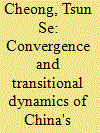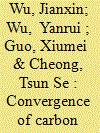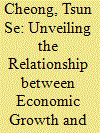| Srl | Item |
| 1 |
ID:
161811


|
|
|
|
|
| Summary/Abstract |
Many scholars have argued that the huge increase in regional inequality in China can be attributed greatly to the disparity in industrialization. This paper contributes to the literature by providing empirical evidence on the transitional dynamics of industrial output by employing a new framework of distribution dynamics analysis, namely, the mobility probability plot (MPP), and a county-level database made up of counties and county-level cities. The new framework can address several inadequacies of the traditional display tools used in the distribution dynamics literature. Stochastic kernel analyses are performed for the nation, the economic zones, and the provinces individually so as to provide an in-depth understanding of the evolution and convergence of industrial output. This study fills the gap in the literature and provides information on mobility of the county-level units, which can greatly aid the policy making process.
|
|
|
|
|
|
|
|
|
|
|
|
|
|
|
|
| 2 |
ID:
150890


|
|
|
|
|
| Summary/Abstract |
This paper investigates the spatial dynamics of per capita carbon dioxide (CO2) emissions in China. The analyses are conducted by employing a continuous dynamic distribution approach and panel data of 286 cities at the prefecture and above-prefecture level. The results show that per capita CO2 emissions tend to converge during the sample period of 2002–2011. However, multimodality is found in the ergodic distribution of the full sample. It is also found that there is more persistence in cities with low per capita CO2 emissions, and more mobility in cities with high per capita CO2 emissions. The analyses also show that the dynamics of per capita CO2 emissions are significantly different among various geographical, income and environmental policy groups. The conditional distribution analyses indicate that multimodality cannot be explained independently by any one of the two factors, namely geographical location or income level. The findings in this study may have important policy implications for CO2 abatement in China.
|
|
|
|
|
|
|
|
|
|
|
|
|
|
|
|
| 3 |
ID:
136273


|
|
|
|
|
| Summary/Abstract |
China has achieved unprecedented success in economic growth since the initiation of economic reforms. The high growth could partly be attributed to the successes in structural transformation of the economy and industrial upgrading of the manufacturing sector toward high value-added products. However, regional inequality in China has increased considerably behind the scenes. In order to have sustainable economic growth, it is thus crucial to investigate the impacts of both structural transformation and industrial upgrading on regional inequality. This paper contributes to the literature by employing a database compiled at the county-level. Decompositions are performed for different spatial groupings so as to provide a clear view of evolution of regional inequality. In addition, the contributions of the major industries to inequality in industrialization are examined by using another database of value-added compiled at the provincial level. The results may have important policy implications for the formulation of a comprehensive and coherent strategy in managing inequality while promoting structural transformation and industrial upgrading.
|
|
|
|
|
|
|
|
|
|
|
|
|
|
|
|
| 4 |
ID:
188152


|
|
|
|
|
| Summary/Abstract |
This study investigates the relationship between economic growth and inequality by employing the artificial neural network approach. There are many important findings. First, this work reveals the underlying functional form of economic growth and inequality by using three-dimensional diagrams. Second, the findings show that there was an inverted-U relationship between economic growth and inequality. This explains apparent contradictions in research findings in the literature. Third, the optimal level of inequality, which corresponds to the highest level of economic growth, is computed for different economies. Our findings were confirmed by the development processes in many developing countries and also in China in recent years, thereby highlighting the importance of inequality alleviation in promoting further economic growth. These findings enable us to derive pragmatic policy implications for other developing countries at different stages of economic development in achieving sustainable growth with equity.
|
|
|
|
|
|
|
|
|
|
|
|
|
|
|
|